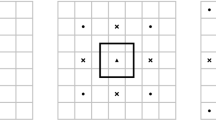Abstract
Symmetries have an important role in turbulence. To some extent, they contain the physics of the equations (conservation laws, etc.), and it is essential that turbulence models respect them. However, as observed by Oberlack (Annual Research Briefs. Stanford University, Stanford 1997) and next by Razafindralandy and Hamdouni (Direct and Large-Eddy Simulation 6: Proceedings of the 6th International ERCOFTAC Workshop on Direct and Large-Eddy Simulation. Springer, Heidelberg, 2006) in the case of an isothermal fluid, only few subgrid stress tensor models preserve the symmetries of the Navier–Stokes equations. In this communication, we present the symmetries of the equations of a non-isothermal fluid flow and analyze some common subgrid stress tensor and flux models under the point of view of these symmetries.
Similar content being viewed by others
References
Bardina, J., Ferziger, J., Reynolds, W.: Improved turbulence models based on large eddy simulation of homogeneous, incompressible, turbulent flows. Tech. Rep. Report TF-19, Stanford University, Stanford (1983)
Cannone, M.: Ondelettes, paraproduits et Navier-Stokes. Diderot Editeur, Arts et Sciences (1995)
Cantwell B. (1978). Similarity transformations for the two-dimensional, unsteady, stream-function equation. J. Fluid Mech. 85: 257–271
Eidson T. (1985). Numerical simulation of the turbulent Rayleigh–Bénard problem using subgrid modelling. J. Fluid Mech. 158: 245–268
Fureby C., Tabor G. (1997). Mathematical and physical constraints on large-eddy simulations. Theor. Comput. Fluid Dyn. 9(2): 85–102
Fushchych W., Popowych R. (1994). Symmetry reduction and exact solutions of the Navier–Stokes equations I. J. Nonlin. Math. Phys. 1(1): 75–113
Hereman C. (1994). Review of symbolic software for the computation of Lie symmetries of differential equations. Euromath Bull. 1(2): 45–79
Horiuti K. (1989). The role of the bardina model in large eddy simulation of turbulent channel flow. Phys. Fluids A 1(2): 426–428
Ibragimov, N.: CRC handbook of Lie group analysis of differential equations, vol 1 Symmetries, exact solutions and conservation laws. CRC Press,West Palm Beach (1994)
Ibragimov, N.: CRC handbook of Lie group analysis of differential equations, vol 3 New trends in theorical developments and computational methods. CRC Press, West Palm Beach (1996)
Keating, A., Piomelli, U., Bremhorst, K., Nesic, S.: Large-eddy simulation of heat transfer downstream of a backward-facing step. J. Turbulence 5(20) (2004)
Kim P., Olver P. (2004). Geometric integration via multi-space. Regular Chaotic Dyn. 9(3): 213–226
Lilly D. (1992). A proposed modification of the Germano subgrid-scale closure method. Phys. Fluids A4(3): 633–635
Lindgren B., Österlund J., Johansson A. (2004). Evaluation of scaling laws derived from lie group symmetry methods in zero-pressure-gradient turbulent boundary layers. J. Fluid Mech. 502: 127–152
Nœther, E.: Invariante Variationsprobleme. In: Königliche Gesellschaft der Wissenschaften, pp. 235–257 (1918)
Oberlack, M.: Invariant modeling in large-eddy simulation of turbulence. In: Annual Research Briefs. Stanford University, Stanford (1997)
Oberlack M. (1999). Symmetries, invariance and scaling-laws in inhomogeneous turbulent shear flows. Flow Turbulence Combust. 62(2): 111–135
Oberlack M., Cabot W., Pettersson Reif B., Weller T. (2006). Group analysis, direct numerical simulation and modelling of a turbulent channel flow with streamwise rotation. J. Fluid Mech. 562: 355–381
Olver P. (1986). Applications of Lie groups to differential equations. Graduate texts in mathematics. Springer, Heidelberg
Olver P. (2001). Geometric foundations of numerical algorithms and symmetry. Appli Algebra Eng. Commun. Comput. 11(5): 417–436
Peng, S.H., Davidson, L.: Comparison of subgrid-scale models in LES for turbulent convection flow with heat transfer. In: 2nd EF Conference in Turbulent Heat Transfer, vol. 1, pp. 5.25–5.35 (1998)
Pukhnachev, V.: Invariant solution of Navier–Stokes equations describing motions with free boundary. Doklady Akademii Nauk SSSR, pp. 202–302 (1972)
Razafindralandy, D., Hamdouni, A.: Consequences of symmetries on the analysis and construction of turbulence models. In: Symmetry, Integrability and Geometry: Methods and Applications vol. 2, Paper 052 (2006)
Razafindralandy, D., Hamdouni, A.: Symmetry invariant subgrid models. In: Lamballais Friedrich, G.M. (ed.) Direct and Large-Eddy Simulation 6: Proceedings of the Sixth International ERCOFTAC Workshop on Direct and Large-Eddy Simulation. Springer, Heidelberg (2006)
Razafindralandy D., Hamdouni A., Béghein C. (2007). A class of subgrid-scale models preserving the symmetry group of Navier–Stokes equations. Commun. Nonlin. Sci. Numer. Simul. 12(3): 243–253
Razafindralandy, D., Hamdouni, A., Oberlack, M.: Analysis and development of subgrid turbulence models preserving the symmetry properties of the Navier–Stokes equations. To appear in Eur. J. Mech.B
Speziale C. (1981). Some interesting properties of two-dimensional turbulence. Phys. Fluids 24: 1425–1427
Ünal G. (1994). Application of equivalence transformations to inertial subrange of turbulence. Lie Group Appl. 1(1): 232–240
Vu K., Carminati J. (2000). Symbolic computation and differential equations: Lie symmetries. J. Symbolic Comput. 29(2): 95–116
Wang L. (1997). Frame-indifferent and positive-denite Reynolds stress-strain relation. J. Fluid Mech. 352: 341–358
Wang, L.: Physics-preserving turbulent closure models: SGS flux vectors of mass and energy. In: 3rd AFOSR International Conference on Direct Numerical Simulation and Large Eddy Simulation (TAICDL) (2001)
Winckelmans, G., Wray, A., Vasilyev, O.: Testing of a new mixed model for LES: the Leonard model supplemented by a dynamic Smagorinsky term. In: Summer Program, pp. 367–388. Center for Turbulence Research, NASA Ames/Standford University (1998)
Author information
Authors and Affiliations
Corresponding author
Additional information
Communicated by M.Y. Hussaini.
Rights and permissions
About this article
Cite this article
Razafindralandy, D., Hamdouni, A. Invariant subgrid modelling in large-eddy simulation of heat convection turbulence. Theor. Comput. Fluid Dyn. 21, 231–244 (2007). https://doi.org/10.1007/s00162-007-0046-1
Received:
Accepted:
Published:
Issue Date:
DOI: https://doi.org/10.1007/s00162-007-0046-1




